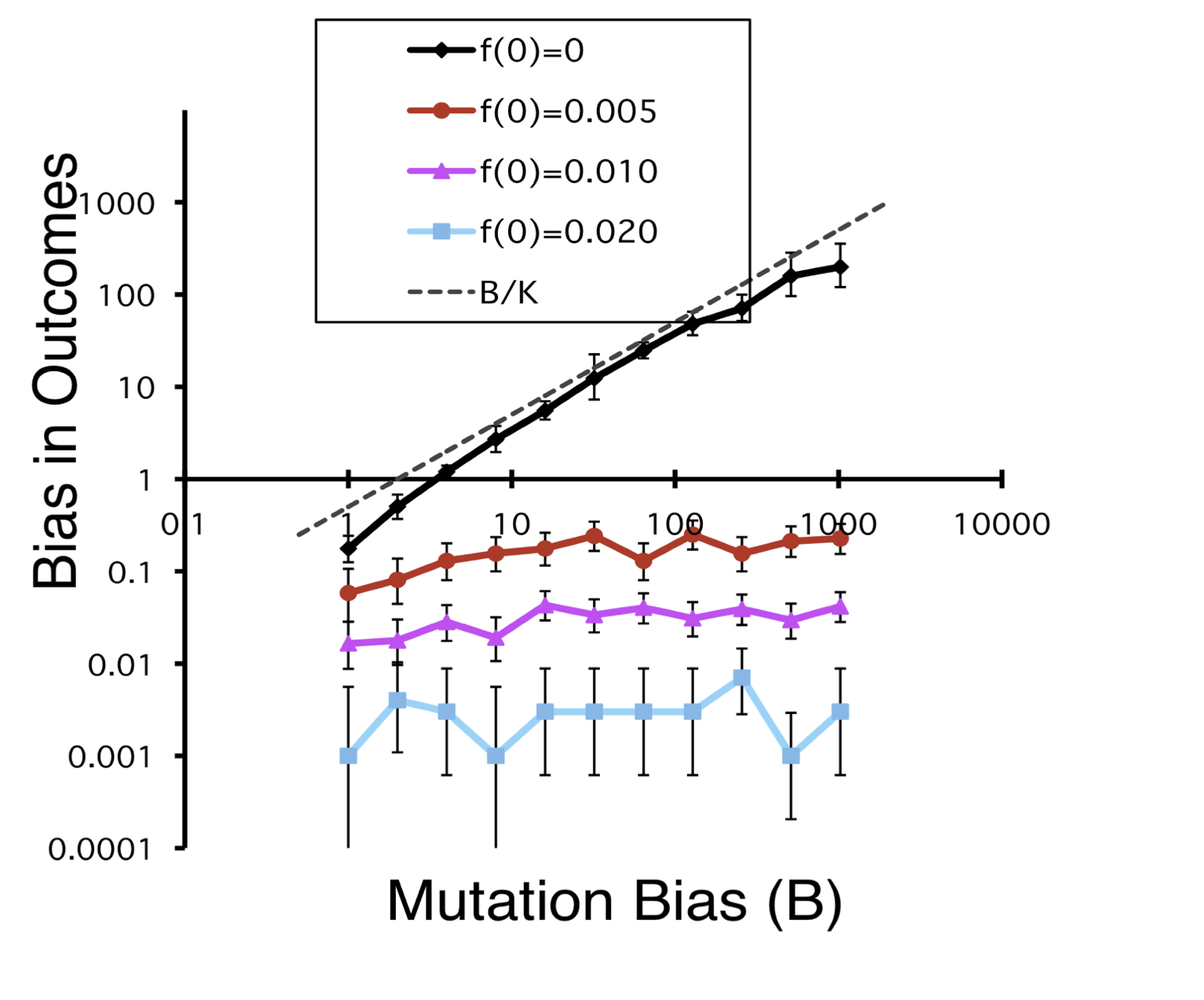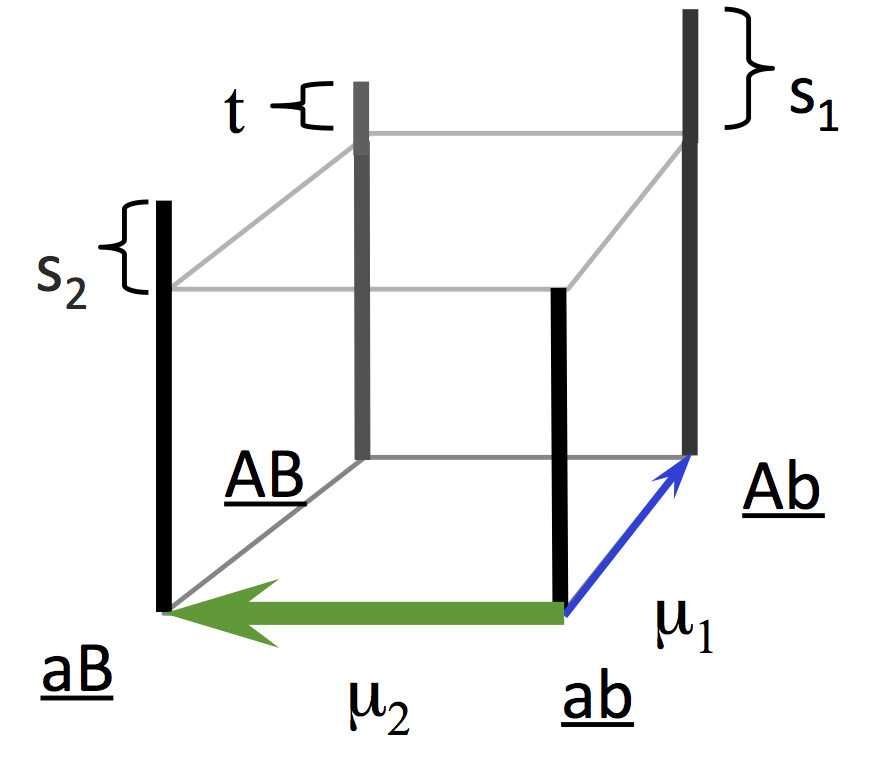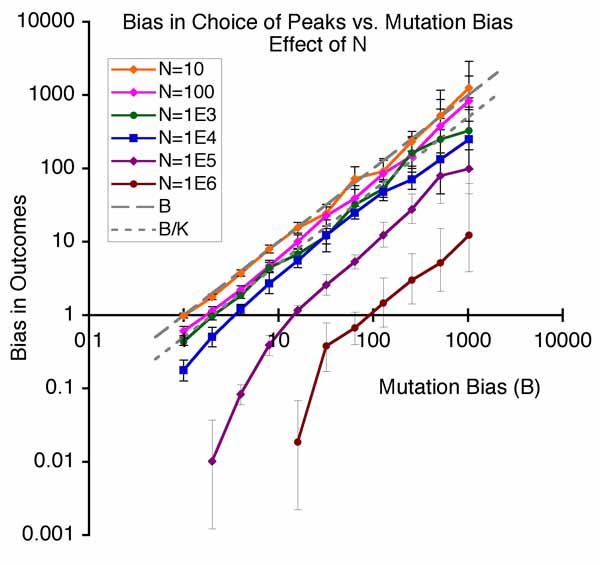The buffet and the sushi conveyor
The return of mutationism to mainstream evolutionary biology is evident in the way mainstream articles now describe the role of mutation in evolution, in our reliance on mathematical models that evoke a mutationist view, and in evo-devo research programs that focus on identifying causative major-effect mutations.
This shift has happened in a kind of sub-conscious way, without commentary or reflection. I’ll comment below on the reasons for that.
My main purpose here is to contrast way that the neo-Darwinian and mutationist views refer implicitly to two different regimes of population genetics evoked in two styles of self-service restaurant: the buffet and the sushi conveyor.
The buffet and the sushi conveyor
Whether we go out to eat at a buffet, or at a sushi restaurant with a conveyor (or moat), we will get to make some choices— we’ll get to select— and ideally we will go home satisfied (evolved, or adapted). But the dynamics of variation and choice are entirely different.
The architects of the Modern Synthesis viewed adaptation according to the buffet model. Just as the staff who tend the buffet will keep it stocked with a variety of choices sufficient to satisfy every customer, the gene pool “maintains” abundant variation sufficient to meet any adaptive challenge (selection never has to wait for a new mutation). Adaptation happens when the customer gets hungry and proceeds to select a platter of food from the abundance of available choices. The items are not chosen arbitrarily or in isolation: they are an ensemble, a balance of flavors that complement each other.

The Buffet: we begin with a practically inexhaustible abundance of static choices, and fill our plate with the desired amount of each dish. A bias in amount does not change outcomes.
Nevertheless, we can think of the perfect meal as a plate that samples every dish, each in exactly the right proportions (i.e., from practically nothing to a full serving). Two profoundly different meals can be chosen for 2 profoundly different customers, simply by differing the amount of each dish.
[By the way, I am not kidding about any of this. Each key point— abundant variation “maintained”, sufficient to meet any challenge, chosen as a balanced ensemble, adaptation as a shift in frequencies— can be documented with citations from multiple “architects” (see Stoltzfus, 2006, Stoltzfus and Cable, 2014 or The Shift to Mutationism is Documented in our Language). The buffet metaphor isn’t perfect, but it comes close. My colleague David McCandlish recommends the salad bar over the buffet, because the architects of the Modern Synthesis clearly saw variations as incomplete parts or raw ingredients, not as finished dishes. I agree that the salad bar is better in that respect, but it fails to convey the themes of magnificent variety and maintained abundance that are conveyed so well by the buffet.]

The sushi conveyor: We iteratively make a yes-or-no choice on the chef’s latest creation as it passes by on a moving conveyor. A bias in the rate of appearance directly biases the outcome.
The experience of the sushi conveyor (or, in a slightly different version, the sushi moat) also gives us a choice, but the nature of the choice is rather different. A limited offering of dishes passes by our table within reach. We do not choose the timing or the amount of these offerings. We simply make an iterative yes-or-no choice of a dish that appears within reach. Our meal may turn out to be well balanced, but there is no actual balancing involved, only stepwise addition
Two views of the roles of selection and mutation
The two views evoke different roles for selection and mutation. In the buffet view (at least, in the “salad bar” version of it), the selector is not just the decider, but the main source of creativity, drawing together something truly distinctive out of an almost infinite variety. In the sushi conveyor view, the selector is also a decider, but is not creative.
The roles of mutation, likewise, are different. In the sushi conveyor view, the process of offering dishes to the customer is dynamic and also creative. The customer chooses (or not) the chef’s latest creation. At the buffet, available variation is abundant and static (and “mutation” happens behind the scenes, when the staff brings out more food to stock the buffet).
A bias in variation will operate completely differently in the two models. Let us suppose that the buffet has 5 apple pies and 1 cherry pie. This makes no difference. A customer who prefers cherry pie will choose a slice of cherry pie, every time; and likewise a customer who prefers apple will choose apple.
But at the sushi conveyor, the effect of a bias will be different. Let us suppose that occasionally a dish of sashimi comes by on the conveyor, with a 5 to 1 ratio of salmon sashimi to tuna sashimi. Even a customer who would prefer tuna in a side-by-side comparison may end up choosing salmon more frequently— a side-by-side comparison simply is not part of the process.
From metaphor to model
The buffet and the sushi conveyor are useful analogies for developing our intuition, because of the way that these analogies map to 2 different regimes of population genetics. The 2 regimes were demonstrated years ago in the twin-peaks model of Yampolsky and Stoltzfus, 2001. In this model, we start with an ab population and evolve either to Ab or aB. That is, we are going on a one-step adaptive walk, and we’ll step either to the left, or to the right. Obviously, if Ab is the more fit alternative (i.e., if s1 > s2) and the mutation rate to Ab is higher (u1 > u2), then Ab is favored. But what if Ab is the more fit alternative, and mutation favors aB? That’s the critical case.
The results are shown below. The upward slope indicates that the bias in outcomes (toward the mutationally favored peak) increases with increased mutation bias. In the smallest population, we are looking at neutral evolution, where only the bias in mutation (dashed line showing B = u1/u2) matters. As population size increases, we enter the sushi conveyor regime of origin-fixation dynamics (or what Gillespie calls “strong selection, weak mutation”), where there is a proportional effect of both mutation bias and fixation bias, shown by the dotted line, which is (s1/s2)*(u1/u2)
As population size gets larger and uN is no longer small, we depart from strict origin-fixation dynamics, but there is still an effect of mutation bias (uN is about 1 and 10 for the 2 largest populations).
Now let’s contrast this with the buffet. Whereas, in the sushi conveyor regime, the customer has to wait for something new to come along, the buffet presents all possibilities, each readily available. Thus, to access the buffet regime, we need to stock the initial population with the alternative genotypes aB and Ab.
As shown below, when the alleles relevant to the outcome of evolution are already present in the initial population, mutation bias just doesn’t matter— the lines are nearly flat, indicating that a thousand-fold change in mutation bias has almost no effect.

When the variants relevant to the outcome of evolution are present in the initial population, biases in mutation don’t matter.
Why? The bias operating so effectively in the sushi conveyor regime is a bias in the introduction process, i.e., a bias in the rate of introduction of new alleles. This kind of bias is a profoundly important effect that directly impacts the course of evolution. But in the buffet regime, there is no bias in the introduction process, because there is no introduction process— all relevant alleles are present already. Once the alleles are present, mutation bias can shift their relative proportions in a biased way, but such shifts are quantitatively trivial compared to the shifts caused by selection (or even drift). This is why the architects of the Modern Synthesis said that mutation was a “weak force” unable to determine the outcome of evolution (the “forces” view is thus inadequate, as explained more fully here).
Concluding thoughts
Now that we are armed with this distinction, we can confront several questions.
First, why did the architects of the Modern Synthesis repeatedly make outrageous assertions, far beyond any available evidence, about the maintenance of variation in the gene pool and the lack of relevance of mutation rates to evolution (examples)? The answer is that they were deeply, ideologically committed to the buffet regime as the regime of population genetics that justifies their pre-existing commitment— a characteristically Darwinian commitment— to seeing selection as powerful and creative while rejecting mutation as weak and inconsequential. Establishing the alleged predominance of the buffet regime was a major rhetorical victory for neo-Darwinism, rightly emphasized in Provine, 1971 as the foundation of the Modern Synthesis.
Second, how and why did mutationism come back? When the architects of the Modern Synthesis said that mutation rates wouldn’t matter in evolution, this was not a logical error: it was the correctly reasoned implication of a mistaken theory. Mutationism returned because the Modern Synthesis failed to account for evolution. This failure began to appear with the earliest protein sequence comparisons in the late 1950s. Unfortunately, the emergence of the Neutral Theory masked the failure of the Modern Synthesis and derailed the return of mutationism. Mainstream thinkers argued that the Modern Synthesis remained true for phenotypes and adaptation, even if it didn’t apply at this strange new “molecular” level. It has taken decades for the evolution community to emerge from this muddle and begin applying mutationist thinking to phenotypes and adaptation.
Third, why isn’t the return of mutationism treated as major news by anyone other than Masatoshi Nei? It is not because the issues have been resolved (e.g., see McCandlish and Stoltzfus, 2014). It is not because the distinction is unimportant. After all, the historiography of evolutionary biology tells us that mutationism is a major alternative theory, a threat to Darwinism that was defeated 100 years ago by the Modern Synthesis.
Instead, this issue is simply lost in the prevailing rhetorical muddle over evolutionary theory, the blame for which rests squarely on the intellectual complacency of defenders of the Modern Synthesis. Because the architects of the Modern Synthesis relied so strongly on empty rhetoric and false dichotomies that their followers were so eager to ingest, they managed to create a scientific consensus largely without conveying to their followers a clear sense of their actual intellectual commitments, although these commitments are often obvious to critics. For instance, let’s look at some typical Modern Synthesis rhetoric, from Wright:
From assisting Prof. Castle, I learned at firsthand the efficacy of mass selection in changing permanently a character subject merely to quantitative variability. Because of this and a distaste for miracles in science, I started with full acceptance of Darwin’s contention that evolution depends mainly on quantitative variability rather than on favorable major mutations.
A critical reader will notice that Wright mischaracterizes Darwin’s position as relying “mainly” rather than exclusively on quantitative variation, suggesting that Wright himself would allow a minority of large variations, and yet, by contrast, Wright implicitly associates major mutations with miracles, suggesting that he rejects them entirely. Clearly Wright is a fan of selection and quantitative variation, but what is his actual position? Selection on quantitative variation was demonstrated by Johannsen and was accepted by Bateson and other Mendelians (see Stoltzfus and Cable, 2014). Is Wright’s position any different from that of the early Mendelians? It isn’t clear. Meanwhile, lazy readers sympathetic to Wright and ignorant of the actual views of early Mendelians come away with the message that Wright relies on well founded experimental results and rejects miracles, while his less rigorous mutationist opponents do not. In reality, Wright’s statement is empty rhetoric and does not signify a distinctive or falsifiable position on substantive scientific issues.
This is why self-styled “neo-Darwinians” today have little clue what the Modern Synthesis or its architects actually stood for. They don’t construe the Modern Synthesis as a specific falsifiable theory: they think it stands for reason and evidence as opposed to superstition and nonsense.
The result is a perpetually unresolved, wishy-washy debate about the status of the “Modern Synthesis”. Defenders see the Modern Synthesis as the theory that includes everything that sounds reasonable, so they simply respond to any well founded criticism with the claim that the Modern Synthesis has incorporated all well founded results. This greedy pseudo–theory version of the “Modern Synthesis” automatically soaks up any novelty like lateral transfer or stress-induced mutation or neutral evolution the moment it becomes a respectable mainstream idea, regardless of whether it was ever part of the actual Modern Synthesis.
Apology for the previous section
Sorry! I’ve ranted far too long on Modern Synthesis Rhetoric and the Dupes Who Fall For It, and that wasn’t the main point here.
The main point is that mutationism has returned, and some aspects of the contrast between mutationism and neo-Darwinism map nicely to 2 different regimes of population genetics that we can illustrate with the buffet and the sushi conveyor. The architects of the Modern Synthesis were committed to the view that evolution takes place in the buffet regime, but the sushi conveyor is back, and it’s here to stay. Molecular evolutionists habitually think this way. The origin-fixation dynamics of the sushi conveyor are built into various software tools for comparative analysis, and also turn up in surprising places like Orr’s mutational landscape model or Streisfeld and Rauscher‘s contribution to the cis-trans debate in evo-devo. The importance of this regime in nature is a live issue in evolutionary genetics that (I would argue) has not received the attention it deserves (McCandlish and Stoltzfus, 2014).


harry pinxteren
July 9, 2015 - 10:06 am
“The main point is that mutationism has returned, ”
After say, about 150 years or so?
“unless profitable variations do occur, natural selection can do nothing.”
Darwin, 1857 Chapter IV Natural Selection
harry pinxteren
July 9, 2015 - 10:11 am
sorry typo!
9, not 7!
Arlin Stoltzfus
July 13, 2015 - 6:21 pm
Harry, thanks for pointing out that naive readers often confuse Darwin’s position with mutationism! We all know *you* know the difference because it came up previously, regarding the passage in which Darwin says that the mutationist view of how evolution works is “not mine” (see https://books.google.com/books?id=7RUZAAAAYAAJ&pg=PA45&lpg=PA45&dq=poulton+argyll+beak+not+mine&source=bl&ots=y2svf_bLzi&sig=RAw8sLMZlT7nGKk9CSDeWow_e6I&hl=en&sa=X&ved=0CCsQ6AEwAmoVChMIksmr6tnYxgIVRtk-Ch1aCgYB#v=onepage&q=poulton%20argyll%20beak%20not%20mine&f=false).
The proponents of modern neo-Darwinism (the “Modern Synthesis”) also distinguished the 2 theories. However, rather than treating these as 2 viable theories, they insisted that evolution in nature works only according to their model. Some of these foolhardy statements are quoted in http://www.molevol.org/the-shift-to-mutationism-is-documented-in-our-language/.
Briefly, the two theories differ on whether mutation is recognized as a source of initiative, discontinuity, direction, and creativity in evolution. Darwinism recognizes variation but only as a random source of raw material, not as a source of creativity, direction, initiative, or discontinuity. In Darwinism, the initiative and direction of evolution is determined externally; creativity is attributed solely to selection; and discontinuity is rejected. In mutationism, selection and mutation both make contributions to initiative and direction; mutation is seen as the source of creativity; and discontinuity is allowed.
Arlin Stoltzfus
July 13, 2015 - 6:27 pm
The general blindness to this issue is also illustrated succinctly in a brief blog by John S. Wilkins (http://evolvingthoughts.net/2010/02/who-started-the-rumor-that-darwin-doesnt-explain-the-origin-of-species-in-the-origin/).
harry pinxteren
July 16, 2015 - 1:49 pm
arlin
I think this quote demonstrates how easy the confusion we are talking about, really is.
One can even claim that Darwin was the first mutationist, because he clearly stated that the arrival of a variation precedes its survival. Besides, a variation should be profitable in order to be selected at all- no matter how small this variation/profit is.
And this isn’t even wrong!.;-)
Arlin Stoltzfus
July 17, 2015 - 6:17 pm
Exactly! It all goes back to Darwin! And if one lowers one’s standards for accreditation *even further*, it all goes back to the bible, including selectionism (many are called, but few are chosen) and neutralism (the race is not to the swift, nor the battle to the strong, but time & chance affecteth all outcomes).
harry pinxteren
July 17, 2015 - 9:26 am
ps
this actually was said in a discusion about A. Wagner’s Arrival of the fittest. Darwin said it all long ago.
So, New or Modern Synthesists, or Darwinists or Selectionists, or whatever they wish to call themselves, think we are having a moot discussion, or else, we finally have to resort to nonsense like ‘lucky mutations’ , ‘ hopeful monsters’ or even to ‘crypto-creationism’.